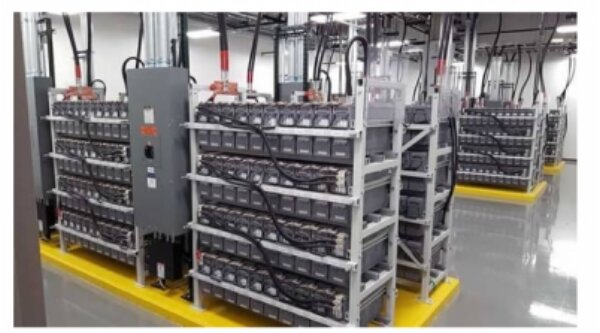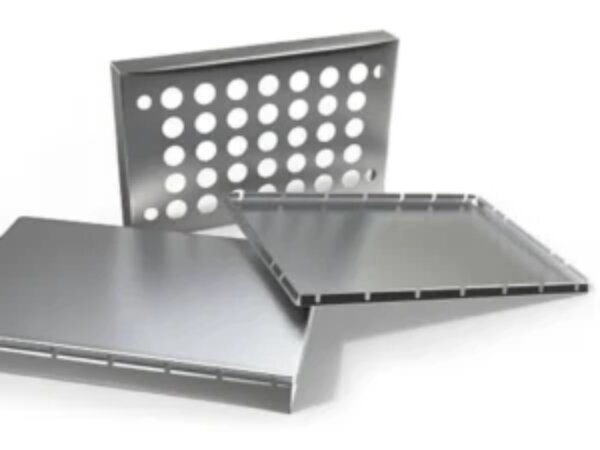Bij metaalbewerking krijgen snijden en buigen vaak de meeste aandacht. Maar wat echt de sterkte en het uiterlijk van een onderdeel bepaalt, komt na deze stappen - de afwerking. Een goede oppervlaktebehandeling kan een gewoon onderdeel veranderen in een onderdeel dat bestand is tegen roest, slijtage en de gevolgen van jarenlang gebruik. Zonder deze behandeling kunnen zelfs goed gemaakte onderdelen voortijdig defect raken.
Afwerking en coating van plaatwerk beschermen onderdelen tegen zware omstandigheden. Ze verbeteren de prestaties, verbeteren het uiterlijk en behouden de betrouwbaarheid van onderdelen na verloop van tijd. Of u nu onderdelen ontwerpt, onderdelen inkoopt of de productie beheert, het kiezen van de juiste afwerking kan de duurzaamheid en kwaliteit aanzienlijk beïnvloeden.
In dit artikel worden verschillende standaard afwerkings- en coatingmethoden besproken, zoals poedercoaten, anodiseren, galvaniseren en passiveren. Elke methode heeft zijn eigen voordelen. Door te begrijpen hoe verschillende afwerkingen sterkte, corrosiebestendigheid en uiterlijk beïnvloeden, kun je beter geïnformeerde keuzes maken die de prestaties en levensduur van je product verbeteren.
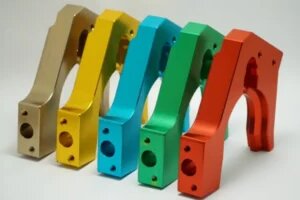
Wat is plaatafwerking?
Plaatbewerking is de laatste fase van fabricage die het uiterlijk, de sterkte en de prestaties van een onderdeel verbetert. Er worden mechanische, chemische of elektrochemische methoden gebruikt om het metaaloppervlak te behandelen. Deze processen verwijderen kleine foutjes, maken ruwe gebieden glad en bereiden onderdelen voor op coatings of verf. Afwerking voegt ook een beschermende laag toe die roest, corrosie en oppervlakteslijtage helpt voorkomen.
Een goede afwerking kan kaal metaal veranderen in een onderdeel dat klaar is voor langdurig gebruik. Het kan oxidatie in vochtige of buitenomstandigheden tegengaan en wrijving tussen bewegende onderdelen verminderen. Afwerkingen maken onderdelen ook makkelijker schoon te maken en zorgen ervoor dat ze er langer mooi blijven uitzien.
Gebruikelijke soorten afwerking van plaatwerk
Elke afwerkingsmethode heeft zijn eigen sterke punten, afhankelijk van de functie van het onderdeel en de werkomgeving. Hieronder staan enkele van de meest populaire en effectieve afwerkingen die gebruikt worden voor plaatwerkonderdelen.
Parelstralen
Parelstralen maakt gebruik van delicate glasparels en perslucht om metalen oppervlakken te reinigen en glad te maken. Dit proces verwijdert roest, oxidatie en bewerkingssporen terwijl de nauwkeurige afmetingen van het onderdeel behouden blijven. Het creëert een mat of satijnachtig oppervlak met een ruwheid van ongeveer Ra 1,0-3,0 μm, waardoor het een geschikte basis vormt voor latere coating of verven.
Het wordt vaak gebruikt op roestvrij staal, aluminium en zacht staal. Parelstralen verbetert de hechting van coatings en geeft onderdelen een schoon, gelijkmatig uiterlijk dat kleine oneffenheden in het oppervlak verbergt. Het is een uitstekende keuze wanneer een consistent uiterlijk en een fijne textuur vereist zijn.
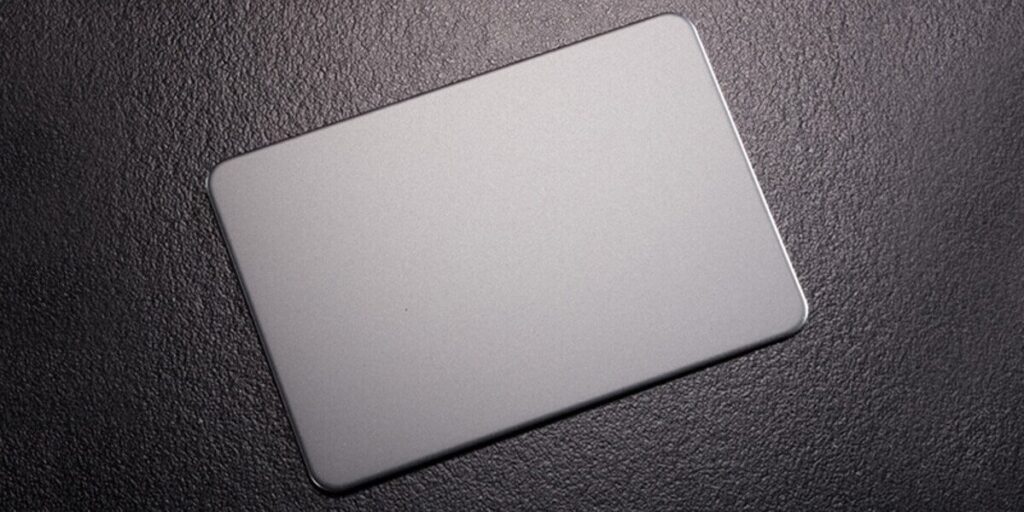
Poedercoating
Poedercoating Hierbij worden geladen poederdeeltjes op een geaard metalen oppervlak gesproeid, waarna ze uitharden in een oven bij 180-200 °C. Het gesmolten poeder vormt een continue, duurzame film van 60-120 μm dik.
Deze coating biedt uitstekende bescherming tegen corrosie, schokken en UV-schade, waardoor hij geschikt is voor zowel binnen- als buitentoepassingen. Onderdelen met poedercoating behouden jarenlang hun kleur en glans, met minimale vervaging of afbladdering. Met talloze kleuren en texturen om uit te kiezen, wordt deze afwerking veel gebruikt voor behuizingen, meubels en machineonderdelen die zowel sterk als visueel aantrekkelijk moeten zijn.
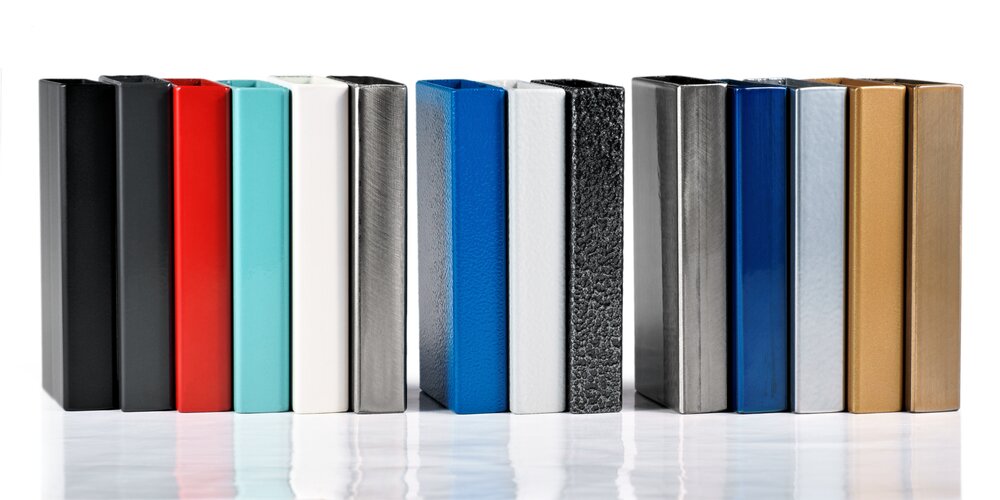
Schilderen
Schilderen voegt een dunne laag van 30-50 μm vloeibare coating toe om het metaal te beschermen en kleur toe te voegen. Het oppervlak wordt gereinigd en soms behandeld met een fosfaatlaag om de hechting van de verf te verbeteren. De onderdelen worden vervolgens gebakken op 120-150°C om de verf uit te harden en de duurzaamheid te verhogen.
Verschillende verven worden voor verschillende doeleinden gebruikt:
- Epoxyverf biedt een sterke chemische weerstand en is zeer geschikt voor industriële machines.
- Acrylverf droogt snel en werkt goed voor meubels of displays binnenshuis.
- Polyurethaanverf Bestand tegen zonlicht en regen, dus ideaal voor buitentoepassingen.
Lakken is flexibel qua kleur en afwerkingsopties en kosteneffectief voor prototypes of kleine series. Hoewel het niet zo sterk is als poedercoaten, geeft het een aantrekkelijk, gemakkelijk schoon te maken oppervlak met een degelijke bescherming tegen weersinvloeden.
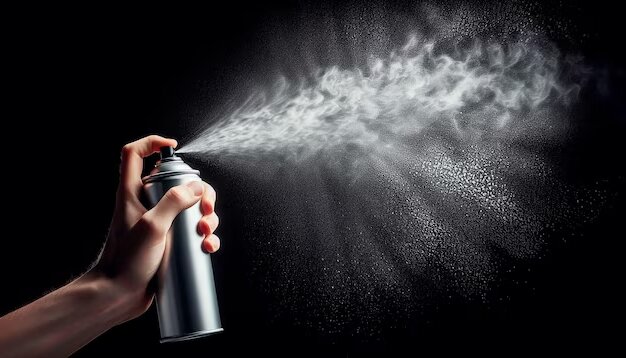
Galvanisch verzinken
Galvanisch verzinken maakt gebruik van een elektrische stroom om een onderdeel te coaten met een dunne laag van een ander metaal, zoals zink, nikkel of chroom. De coating is meestal 2-25 μm dik.
- Verzinken biedt corrosiebestendigheid en een glanzend zilveren uiterlijk.
- Vernikkelen voegt hardheid en slijtvastheid toe.
- Verchromen levert een spiegelachtige afwerking met een hoge duurzaamheid.
Gegalvaniseerde onderdelen worden vaak gebruikt in de auto-industrie, elektronica en decoratieve producten, waar zowel het uiterlijk als de prestaties essentieel zijn.
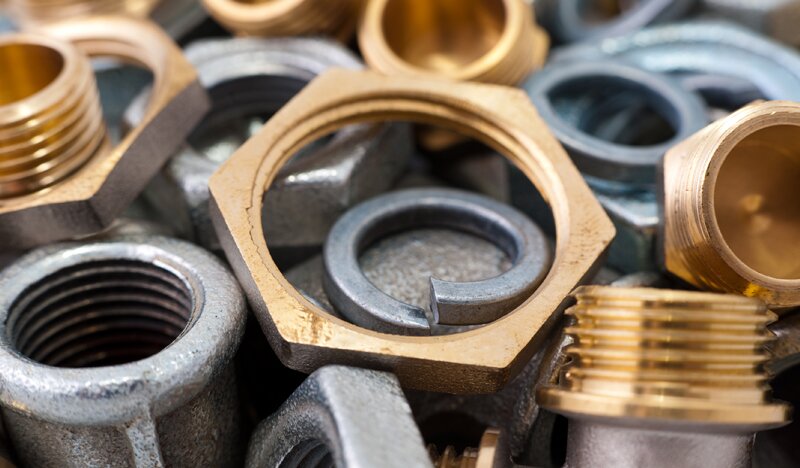
Anodiseren
Anodiseren wordt voornamelijk gebruikt op aluminium om de corrosieweerstand en oppervlaktehardheid te verbeteren. Het aluminium onderdeel wordt in een zuurbad geplaatst en een elektrische stroom vormt een stevig gebonden oxidelaag van 10-100 μm dik.
Geanodiseerd aluminium kan in verschillende kleuren worden geverfd. Omdat de kleurstof in de oxidelaag wordt opgenomen, zal deze niet afschilferen of afbladderen. Daarna wordt het oppervlak verzegeld in heet water om de poriën te sluiten en de kleur in te sluiten.
- Type II anodiseren (zwavelzuur) is gebruikelijk voor consumenten en architecturaal gebruik.
- Type III anodiseren, ook bekend als hard anodiseren, creëert een dikkere, hardere laag voor luchtvaart- en industriële onderdelen.
Geanodiseerde onderdelen bieden ook een sterke elektrische isolatie, waardoor ze geschikt zijn voor behuizingen, koellichamen en elektronische componenten.
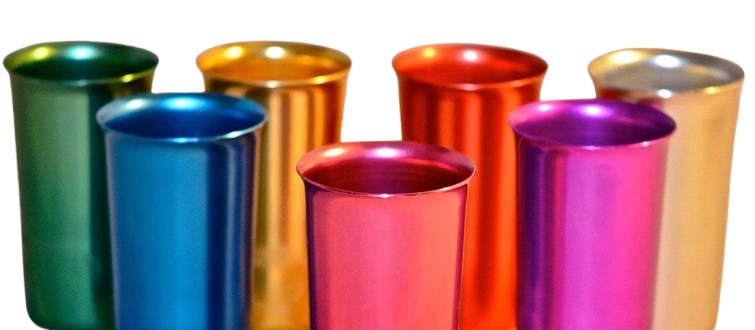
Passiveren en chemische film
Passiveren verbetert de corrosieweerstand van roestvast staal door vrij ijzer en onzuiverheden van het oppervlak te verwijderen. Het vormt een dunne, onzichtbare oxidelaag zonder het uiterlijk van het onderdeel te veranderen.
Voor aluminium biedt een chemische filmcoating zoals chromaatomzetting een vergelijkbare bescherming. Deze coatings zijn fragiel, meestal minder dan één μm, en behouden hun elektrische geleidbaarheid terwijl ze bestand zijn tegen oxidatie. Beide behandelingen worden vaak gebruikt in behuizingen en elektrische assemblages waar geleidbaarheid en corrosiebestendigheid essentieel zijn.

E-Coating
E-coating, ook bekend als elektroforetische coatingbrengt de verf gelijkmatig aan met behulp van een elektrisch veld. Het onderdeel wordt ondergedompeld in een verfbad op waterbasis, geladen en vervolgens gebakken op 160-190°C. De uiteindelijke coating is meestal 20-35 μm dik en bedekt zelfs complexe vormen en krappe hoeken.
E-coating biedt gladde, glanzende afwerkingen met een uitstekende weerstand tegen corrosie. Het wordt veel gebruikt bij de productie van auto's en apparaten omdat het een consistente dekking, sterke hechting en weerstand tegen afschilferen en vervagen biedt.

Warm zwarten
Heet zwarten, ook wel zwarte oxidelaag genoemdvormt een dunne zwarte laag op staal of ijzer. Onderdelen worden in een reeks verwarmde chemische baden gedompeld die een oxidelaag van ongeveer 1 μm dik creëren.
Deze afwerking biedt een milde bescherming tegen corrosie, vermindert schittering en geeft een gelijkmatig donker uiterlijk. Het wordt vaak gebruikt voor gereedschappen, bevestigingsmiddelen en precisieonderdelen die een strakke, professionele uitstraling moeten hebben met behoud van strakke afmetingen.

Hoe de afwerking van plaatwerk de prestaties verbetert?
Oppervlaktebehandeling zorgt er niet alleen voor dat onderdelen er goed uitzien - het heeft een direct effect op hoe goed ze presteren en hoe lang ze meegaan. Elk type oppervlaktebehandeling speelt een cruciale rol in het beschermen van het onderdeel en het minimaliseren van de kosten op lange termijn.
Corrosie en slijtvastheid
Metalen onderdelen hebben vaak te maken met zware omstandigheden, zoals vocht, chemicaliën of wrijving. Zonder de juiste afwerking kunnen deze factoren roest, oxidatie of slijtage van het oppervlak veroorzaken. Afwerkingen zoals poedercoaten, anodiseren en galvaniseren creëren een beschermende laag die deze problemen voorkomt. Een stalen behuizing met poedercoating is bijvoorbeeld jarenlang bestand tegen weersinvloeden buiten, terwijl geanodiseerd aluminium stabiel blijft in vochtige of maritieme omgevingen.
Afwerkingen beschermen ook tegen mechanische slijtage door herhaald contact of beweging. Hard anodiseren en vernikkelen maken oppervlakken gecompliceerder en beter bestand tegen krassen of schuren. Door corrosie en slijtage te verminderen, verlengt oppervlakteafwerking de levensduur van het onderdeel en verlaagt het de onderhoudskosten - een belangrijk voordeel bij zowel productie als dagelijks gebruik.
Esthetische en merkvoordelen
Een kwaliteitsafwerking geeft een product een professionele, hoogwaardige uitstraling. Gladde, gelijkmatige coatings zorgen ervoor dat onderdelen er precies en duurzaam uitzien, wat het vertrouwen van de klant in het merk versterkt. Afwerkingen, zoals poedercoaten en verven, zijn verkrijgbaar in een breed scala aan kleuren en texturen, waardoor bedrijven de flexibiliteit hebben om hun merk- en ontwerpdoelstellingen te realiseren.
Voor consumentenproducten zijn het uiterlijk en het gevoel net zo belangrijk als de functie. Een gesatineerd oppervlak of glanzende poedercoating straalt kwaliteit en aandacht voor detail uit. Naast het uiterlijk voorkomen afwerkingen ook vervaging en verkleuring, waardoor producten er na verloop van tijd netjes uit blijven zien.
Elektrische en thermische prestaties
Sommige afwerkingen verbeteren het vermogen van een onderdeel om met elektriciteit of warmte om te gaan. Nikkel of koper galvaniseren verbetert de elektrische geleiding, waardoor het ideaal is voor gebruik in terminals, connectoren en elektronische componenten. Anderzijds zorgt geanodiseerd aluminium voor isolatie op plaatsen waar onderdelen de stroom moeten blokkeren, zoals behuizingen of koellichamen.
Afwerkingen kunnen ook de warmteoverdracht verbeteren. Beschermende coatings die oxidatie tegengaan zorgen voor stabiele thermische prestaties, vooral in onderdelen zoals voedingen of LED-modules. Het kiezen van de juiste afwerking op basis van elektrische of thermische behoeften zorgt ervoor dat het onderdeel veilig en efficiënt werkt in de praktijk.
Hoe kies je de juiste afwerking van plaatwerk?
Elk onderdeel heeft andere prestatiebehoeften en de beste afwerking hangt af van waar en hoe het gebruikt zal worden. De juiste keuze verbetert zowel de functie als het uiterlijk. Dit zijn de belangrijkste aandachtspunten bij het kiezen van een afwerking.
Hoe stem je de afwerking af op het materiaal?
Verschillende metalen reageren verschillend op afwerkingsmethoden. Het basismateriaal bepaalt welke behandelingen goed hechten en duurzame bescherming bieden.
Aluminium werkt het best met anodiseren, dat de hardheid verhoogt en een waaier aan kleuropties biedt. Het gaat ook goed samen met poedercoaten of verven als extra corrosiebestendigheid of decoratie nodig is.
Roestvast staal heeft het meeste baat bij passiveren en parelstralen, die reinigen en beschermen zonder de natuurlijke corrosiebestendigheid te verminderen. Voor een donkerder of glanzender uiterlijk kan E-coating of elektrolytisch polijsten worden gebruikt.
Mild staal heeft een sterkere bescherming nodig omdat het gemakkelijk roest. Verzinken, poedercoaten en verven zijn veelgebruikte opties om een stevige barrière te vormen tegen vocht en oxidatie.
Koper en messing worden vaak gebruikt met transparante coatings of vernikkeling om aanslag te voorkomen terwijl hun metallic kleur behouden blijft. Aangezien elk metaal anders reageert op zijn omgeving, zorgt het kiezen van een compatibele afwerking voor zowel langdurige prestaties als een aantrekkelijk uiterlijk.
| Afwerking | Koolstofstaal | Roestvrij staal | Aluminium | Koperlegeringen | Gegalvaniseerd staal |
|---|---|---|---|---|---|
| Zwart oxide | Geschikt voor gereedschappen, armaturen en bevestigingsmiddelen; voegt lichte corrosieweerstand toe. | Wordt normaal gesproken niet gebruikt. | Niet geschikt. | Niet geschikt. | Niet geschikt. |
| Galvanisch verzinken | Wordt gebruikt voor zink-, nikkel- of chroomcoatings om het uiterlijk en de corrosiebescherming te verbeteren. | Meestal niet nodig vanwege de natuurlijke corrosiebestendigheid. | Niet vaak gebruikt. | Vaak gebruikt voor decoratieve of beschermende afwerkingen van nikkel en chroom. | Niet aanbevolen. |
| Anodiseren | Niet geschikt. | Niet geschikt. | Gebruikelijk voor aluminium onderdelen; verbetert de slijtvastheid en kleurstabiliteit. | Niet geschikt. | Niet geschikt. |
| Schilderen | Gebruikelijke, goedkope afwerking; voegt corrosie- en weerbescherming toe. | Werkt als een extra barrièrelaag; aanpasbare kleuren. | Flexibele afwerking voor prototypes en consumentenproducten. | Biedt weerstand tegen kleur en aanslag. | Vaak gebruikt voor onderdelen voor buiten die visueel uniform moeten zijn. |
| Poedercoating | Biedt duurzame en slagvaste coating; wordt gebruikt voor machines en onderdelen voor buiten. | Ideaal voor industriële toepassingen die zowel duurzaamheid als uiterlijk nodig hebben. | Populaire decoratieve afwerking met sterke corrosiebescherming. | Aangebracht voor langdurige kleurbescherming. | Verbetert de corrosieweerstand op voorgelakte onderdelen. |
| Passiveren | Niet van toepassing. | Verbetert de corrosiebestendigheid en oppervlaktestabiliteit. | Niet geschikt. | Niet geschikt. | Niet geschikt. |
| Polijsten | Maakt het oppervlak gladder en verbetert het uiterlijk. | Produceert spiegel- of geborstelde afwerking. | Verbetert reflectie en gladheid. | Gebruikt voor decoratieve verfraaiing. | Verbetert het uiterlijk en de netheid van het oppervlak. |
| Zandstralen | Reinigt oxidatie en bereidt oppervlakken voor op coating. | Verwijdert aanslag en verbetert de hechting van het oppervlak. | Creëert een gelijkmatige matte textuur. | Gebruikt om schoon te maken en te structureren voor het afwerken. | Bereidt het oppervlak voor op verven of poedercoaten. |
Wat is de bedrijfsomgeving van het onderdeel?
De omgeving heeft een grote invloed op de levensduur van een vis. Onderdelen die worden gebruikt in vochtige, zoute of chemisch rijke omgevingen vereisen een hoge corrosiebestendigheid. Poedercoaten en anodiseren zijn zeer geschikt voor toepassingen buitenshuis of in de buurt van water. Voor toepassingen binnenshuis biedt galvaniseren of passiveren meestal voldoende bescherming.
Wanneer onderdelen worden blootgesteld aan hitte, wrijving of contact met andere onderdelen, kies dan afwerkingen die bestand zijn tegen mechanische slijtage. Voor medische of voedingsmiddelenapparatuur zijn gladde en reinigbare afwerkingen, zoals gepolijst roestvrij staal of geanodiseerd aluminium, ideaal.
Wat zijn je prestatiebehoeften?
Elke afwerking biedt verschillende mechanische en functionele voordelen. Voor slijtvastheid gebruik je hard anodiseren of vernikkelen. Voor elektrische geleiding kies je verzinken of een chemische filmcoating, die een goed contact tussen de metalen oppervlakken in stand houdt.
Als visuele consistentie uw doel is, zorgen E-coating en poedercoating voor een uniforme kleur en glans. Bewegende onderdelen profiteren van gladdere oppervlakken die wrijving verminderen en voortijdige slijtage voorkomen. Door de afwerking af te stemmen op het doel van uw onderdeel, blijven de prestaties en betrouwbaarheid na verloop van tijd behouden.
Wat zijn uw budget- en tijdsbeperkingen?
Kosten en tijd bepalen vaak de afwerkingsbeslissingen. Spuiten en parelstralen zijn betaalbaar en snel, waardoor ze geschikt zijn voor prototypes of kleinschalige productieseries. Poedercoaten en e-coaten vereisen langere insteltijden, maar zijn efficiënter voor massaproductie.
Als de tijd beperkt is, kies dan afwerkingen met korte uithardings- of droogtijden. Voor besparingen op lange termijn kan investeren in duurzame afwerkingen toekomstige onderhouds- en vervangingskosten verlagen.
Welke look wil je bereiken?
De afwerking van het oppervlak bepaalt hoe het product eruitziet en aanvoelt. Een matte of geborstelde afwerking geeft een industriële stijl, terwijl een verchroomde of glanzende poedercoating een moderne, high-end look creëert.
Kleur, glans en textuur beïnvloeden hoe klanten kwaliteit waarnemen. Ontwerpers kiezen vaak afwerkingen die passen bij het imago van hun merk en tegelijkertijd een balans vinden tussen prestaties en kosten.
Shengens afwerkings- en coatingmogelijkheden
Bij Shengen ondersteunen we projecten van prototype tot productie. We bieden een complete set afwerkings- en coatingdiensten. We richten ons op stabiele kwaliteit en snelle levertijden.
We hebben verschillende interne afwerkingsopties om controle en snelheid te behouden:
- Poedercoating: We bieden verschillende texturen en glansniveaus. De coating hecht goed en gaat buiten mee. Hij is geschikt voor behuizingen, frames en structurele onderdelen.
- Schilderen: We passen de kleuren snel aan voor prototypes en kleine oplages. De afwerking ziet er glad en schoon uit.
- Parelstralen en zandstralen: We maken het oppervlak schoon en glad voordat we het coaten. De matte textuur zorgt ervoor dat verf of poeder beter blijven zitten.
- Polijsten en borstelen: We verbeteren het uiterlijk, verwijderen fijne krasjes en zorgen voor een satijnen of spiegelende afwerking.
We werken ook samen met vertrouwde oppervlaktebehandelaars voor speciale behoeften:
- Anodiseren (types II en III): We verbeteren aluminium met verbeterde slijtvastheid en corrosiebestendigheid. We bieden transparante, zwarte en aangepaste kleuren.
- Galvanisch: We voegen zink, nikkel of chroom toe voor bescherming of om het uiterlijk te verbeteren. Waar nodig verbeteren we ook de geleidbaarheid.
- E-Coating: We leveren een gladde, gelijkmatige film op complexe vormen. Het resultaat ziet er hoogwaardig en consistent uit.
- Passiveren: We behandelen roestvrij staal om de corrosiebestendigheid te verbeteren zonder het uiterlijk of de oppervlaktestructuur te veranderen.
U kunt ons uw tekeningen en specificaties sturen. Ons team bekijkt je materiaal, je doelen en je budget. We maken een nauwkeurige offerte met doorlooptijd en technische opmerkingen.
Onze ingenieurs kunnen je helpen bij het vergelijken van keuzes. We kunnen uitleggen wanneer poedercoaten beter is dan anodiseren en wanneer een andere afwerking beter past. Geef ons de details van je onderdeel en we geven je een gratis advies over de oppervlaktebehandeling en een prijsopgave.
Veelgestelde vragen over het afwerken van plaatmetaal
Hier vind je antwoorden op een aantal veelgestelde vragen over oppervlakteafwerking en -coating van plaatmetaal. Deze details kunnen je helpen om je afwerkingsproces met duidelijke verwachtingen te plannen.
Kan ik de kleur of textuur van mijn afwerking aanpassen?
Ja. We bieden full-color maatwerk volgens de RAL- of Pantone-normen. Poedercoating, verven en anodiseren kunnen een breed scala aan kleuren en oppervlaktestructuren bereiken - van zachte, matte afwerkingen tot glanzende glans. Voor merkmatching kunnen we vóór productie steekproeven uitvoeren om de kleurnauwkeurigheid en consistentie te bevestigen.
Hoe dik worden de coatings meestal aangebracht?
De dikte van de coating varieert naargelang het type afwerking en de functionele behoeften:
- Poedercoating: 60-120 μm
- Spuiten: 30-50 μm
- Anodiseren: 10-100 μm (afhankelijk van type II of type III)
- Galvanisch: 2-25 μm
- E-Coating: 20-35 μm
Onze technici controleren de dikte van de coating tijdens de productie om een uniforme dekking en goede bescherming te garanderen.
Wat is de typische doorlooptijd voor afwerking?
De levertijd hangt af van het proces en de ordergrootte. Eenvoudige afwerkingen, zoals parelstralen of verven, duren meestal 3-5 dagen voor kleine batches. Meer geavanceerde afwerkingen, zoals anodiseren of galvaniseren, kunnen 7-10 dagen in beslag nemen, inclusief oppervlaktevoorbereiding en inspectie. Grote productieseries worden gepland om zowel een hoge kwaliteit als een snelle doorlooptijd te garanderen.
Kunnen onderdelen indien nodig worden nabewerkt of bijgewerkt?
Ja, in de meeste gevallen wel. Coatings zoals verf, poedercoating of anodiseren kunnen worden verwijderd en opnieuw worden aangebracht. Het exacte proces hangt af van het materiaal en het type afwerking. Dunne aluminium onderdelen moeten bijvoorbeeld voorzichtig worden behandeld om schade te voorkomen. Voor het herbewerken inspecteert ons team elk onderdeel om de veiligste en meest kosteneffectieve oplossing te vinden.
Bieden jullie certificeringen of kwaliteitstesten aan?
Ja. Alle afgewerkte onderdelen worden voor verzending gecontroleerd op hechting, dikte en oppervlak. Op verzoek kunnen we RoHS-certificaten, zoutsproeitestresultaten en hardheidsrapporten leveren om te voldoen aan de specifieke kwaliteitseisen van uw project.
Hey, ik ben Kevin Lee

De afgelopen 10 jaar heb ik me verdiept in verschillende vormen van plaatbewerking en ik deel hier de coole inzichten die ik heb opgedaan in verschillende werkplaatsen.
Neem contact op

Kevin Lee
Ik heb meer dan tien jaar professionele ervaring in plaatbewerking, gespecialiseerd in lasersnijden, buigen, lassen en oppervlaktebehandelingstechnieken. Als technisch directeur bij Shengen zet ik me in om complexe productie-uitdagingen op te lossen en innovatie en kwaliteit in elk project te stimuleren.


